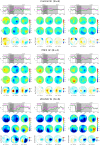Large-Scale Assessment of a Fully Automatic Co-Adaptive Motor Imagery-Based Brain Computer Interface
- PMID: 26891350
- PMCID: PMC4758702
- DOI: 10.1371/journal.pone.0148886
Large-Scale Assessment of a Fully Automatic Co-Adaptive Motor Imagery-Based Brain Computer Interface
Abstract
In the last years Brain Computer Interface (BCI) technology has benefited from the development of sophisticated machine leaning methods that let the user operate the BCI after a few trials of calibration. One remarkable example is the recent development of co-adaptive techniques that proved to extend the use of BCIs also to people not able to achieve successful control with the standard BCI procedure. Especially for BCIs based on the modulation of the Sensorimotor Rhythm (SMR) these improvements are essential, since a not negligible percentage of users is unable to operate SMR-BCIs efficiently. In this study we evaluated for the first time a fully automatic co-adaptive BCI system on a large scale. A pool of 168 participants naive to BCIs operated the co-adaptive SMR-BCI in one single session. Different psychological interventions were performed prior the BCI session in order to investigate how motor coordination training and relaxation could influence BCI performance. A neurophysiological indicator based on the Power Spectral Density (PSD) was extracted by the recording of few minutes of resting state brain activity and tested as predictor of BCI performances. Results show that high accuracies in operating the BCI could be reached by the majority of the participants before the end of the session. BCI performances could be significantly predicted by the neurophysiological indicator, consolidating the validity of the model previously developed. Anyway, we still found about 22% of users with performance significantly lower than the threshold of efficient BCI control at the end of the session. Being the inter-subject variability still the major problem of BCI technology, we pointed out crucial issues for those who did not achieve sufficient control. Finally, we propose valid developments to move a step forward to the applicability of the promising co-adaptive methods.
Conflict of interest statement
Figures






References
-
- Wolpaw JR, Wolpaw EW, editors. Brain-computer interfaces: principles and practice. Oxford University press; 2012. ISBN-13: 978-0195388855.
-
- Dornhege G, del R Millán J, Hinterberger T, McFarland D, Müller KR, editors. Toward Brain-Computer Interfacing. Cambridge, MA: MIT Press; 2007.
Publication types
MeSH terms
LinkOut - more resources
Full Text Sources
Other Literature Sources

